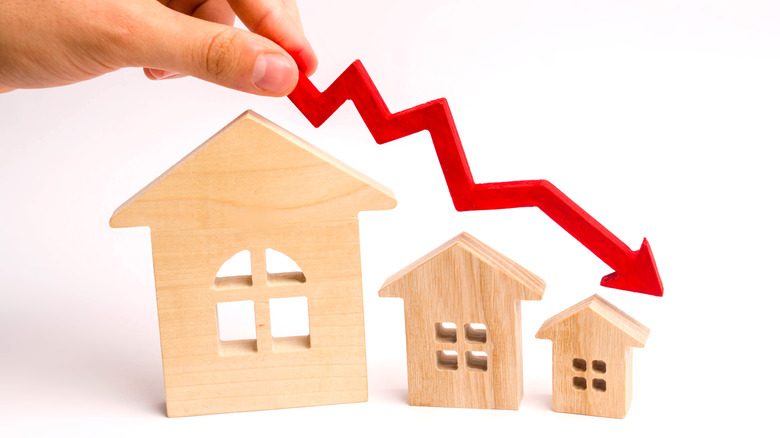Report Uncovers The States Most Vulnerable To Housing Market Instability
Prospective buyers and current homeowners have been facing a tumultuous housing market since the latter half of 2022. Attom Data Solutions has found that home value across the nation is seeing an 8% decrease, 4% down from the fourth quarter of last year. At a time when 30-year mortgage rates are close to 7%, and inflation is at a 40-year high, communities are seeing homeowner equity frozen, foreclosures on the rise, and mortgage loan applications hitting their lowest numbers in nearly nine years. Unfortunately, those who live in California, New Jersey, Illinois, Delaware, and Ohio may be hit particularly hard by the current housing market, according to Attom's data.
"With the U.S. housing market cooling off considerably since the middle of last year, some areas of the country continue to show signs of being more at risk of a larger downturn than others," said Attom chief executive officer, Rob Barber. "That's based on several key factors that can neither boost or damage local housing markets, including unusually high homeownership costs, foreclosures, and relatively weak homeowner equity." Attom released a special housing risk report, evaluating the different markets across the U.S. and determining which states and counties are more or less vulnerable to instability. However, Barber notes that Attom is not naming areas on their way to impending decline and is only looking at those more exposed to market difficulties.
The most vulnerable states
Attom's report measured the most vulnerable states by counties with the highest percentage of foreclosures, unemployment rates, average median single-family home wages, and mortgage equilibriums that transcend a property's value — underwater mortgages. The rankings were based on 581 counties across the United States, showing California, New Jersey, Illinois, Delaware, and Cleveland, Ohio, as the most at-risk areas. The most prominent housing issues were in New York City and Chicago municipal areas. Within the top 50 most at-risk counties out of the 581 surveyed, it included seven counties in Chicago (Cook, DeKalb, Kane, Kendall, Lake, McHenry, and Will), two in New York City (Kings and Richmond), and three in New York City suburbs (Essex, Passaic, and Sussex in New Jersey). Three counties ranked in the top 50 from Cleveland, Ohio (Cuyahoga, Lake, and Lorain). California saw a high number of 13 counties make it into the top 50, with Butte, Solano, Fresno, and Kern counties among them.
Attom found that in 34 of the 50 ranked counties, single-family median homes saw more than one-third of their income surrendered to home ownership costs compared to 32.3% of local wages going towards the home nationwide. In the fourth quarter of 2022, 7% of mortgages went underwater in 25 out of 50 counties, while 5.9% of properties experienced this nationally. In 44 out of 50 counties in the last quarter of 2022, over 1 in 1,000 households faced foreclosures compared to 1 in 1,549 across the nation.
The least vulnerable states
As Attom's data was able to identify the areas most vulnerable to the problems plaguing the housing market, it was also able to form a report on the least susceptible. The lowest at-risk states include southern and midwestern areas and some western states, excluding California. Out of the 581 counties surveyed, 50 fell into the least-affected category, including 17 counties in the midwest, 15 in the south, nine in the west, and nine in the northeast. These communities saw a decrease in underwater mortgages, foreclosures, and unemployment in the fourth quarter of 2022. Out of the 50 ranked counties, 31 had less than 5% of upside-down mortgages; the lowest rates were found in Chittenden County, Vermont; Martin County, Flordia; San Mateo and Santa Clara, California; and Gallatin County, Montana.
Attom found that every one of the 50 least vulnerable counties had an unemployment rate of less than 3%, with the lowest percentages seen in Cass, North Dakota; Olmsted, Minnesota; Shelby, Alabama; and Gallatin and Yellowstone, Montana. Counties with the lowest portion of income dedicated to home ownership expenses were Morgan and Limestone County in Alabama, Winnebago County in Wisconsin, Tippecanoe County in Indiana, and Olmsted County in Minnesota.


